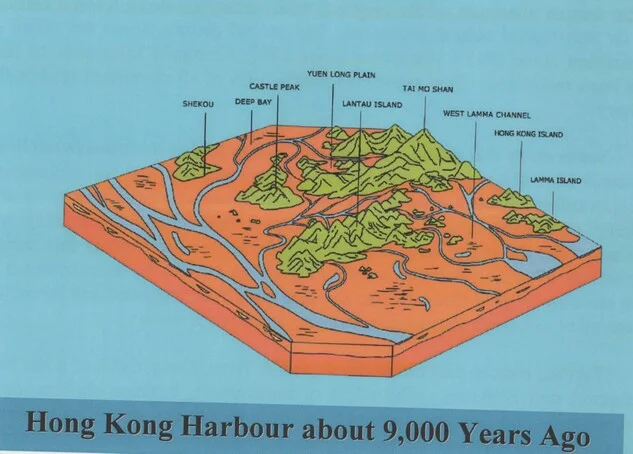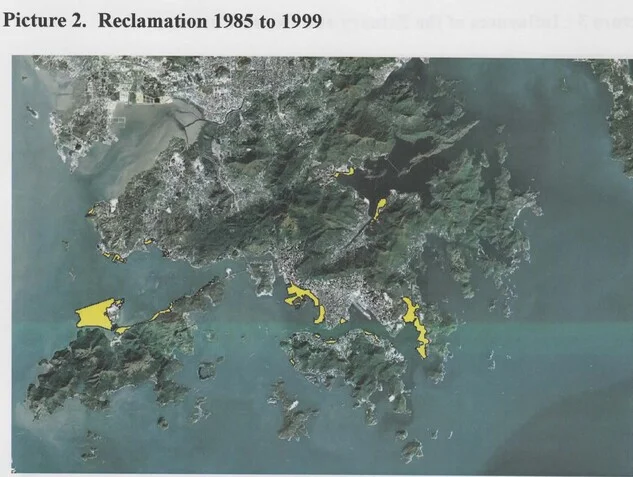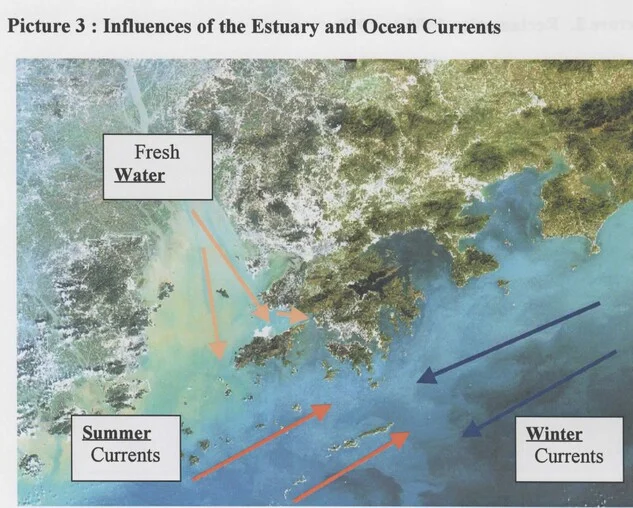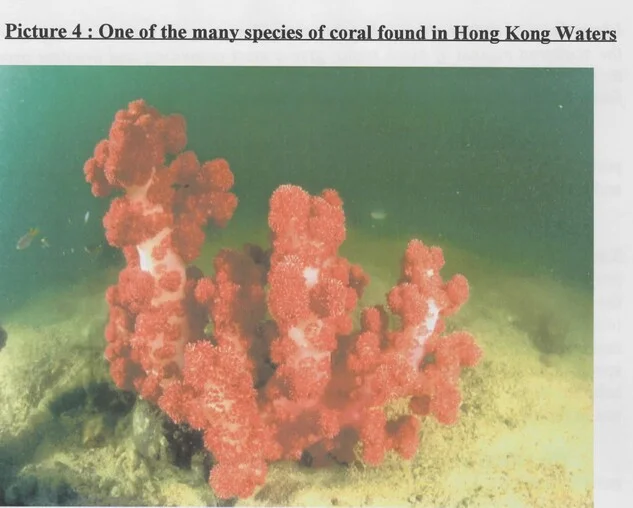d5s10
archive > archive documents
The Environment of Hong Kong’s Harbour
Past Present and
Future
Presentation by Kim Salkeld
Nautical Institute HK
Branch Seminar
3O November 2001
steadily worse. Looking at Hong Kong’s Harbour, I’d like to suggest a more
dynamic picture of the environment. I will look at three aspects of the harbour :
the physical environment; natural ecology and then man made pollution, setting
out some of the historical changes and a few thoughts on where the influences at
work in each of these areas are likely to take us in years ahead.
The Physical Environment.
The illustration below shows what the harbour of Hong Kong looked like
about 9,000 years ago:

As you can see there was no harbour at all. The port of Hong Kong is
the
consequence of major increases in the sea level after the end of the last ice age.
consequence of major increases in the sea level after the end of the last ice age.
Natural processes of changing sea levels, changing land levels and
sedimentation all continue to have significant effects on the harbour. For
example, rising land, coupled with siltation, is changing the very badly named
Deep Bay quite rapidly.
Old physical features still have very marked effects on the harbour, and
not just the mountainous islands that have been left by the rising sea to give
shelter to the harbour from wind and waves. The sand laid down over millennia
in the old riverbeds is the source of the sand used to form most of the
reclamation in Hong Kong. In tum, the pits left after the sand has
been removed
have become the sites where mud is deposited after it has been removed from
other parts of the harbour during maintenance dredging or excavation before
new reclamation work. Carefully selected pits — those not exposed to strong
tidal scouring or wave action - are where mud contaminated by years of on shore
industrial activity and vessel maintenance can be deposited and then isolated by
layers of clean mud covering.
have become the sites where mud is deposited after it has been removed from
other parts of the harbour during maintenance dredging or excavation before
new reclamation work. Carefully selected pits — those not exposed to strong
tidal scouring or wave action - are where mud contaminated by years of on shore
industrial activity and vessel maintenance can be deposited and then isolated by
layers of clean mud covering.
The reclamation and dredging activity is the sign of man at work, altering
the physical environment to suit human needs. Over the last 150 years, the scale
of that human alteration of the physical environment of Hong Kong’s harbour
has far outweighed natural processes. My second picture shows the extent of
reclamation since 1985. Altogether since 1887, 62 square kilometres of land
have been reclaimed. That represents nearly 30% of all developed land in the
tenitory.
Some worry that global warming will lead to further increases in sea level.
Measures have already been taken locally to increase sea wall and reclamation
levels to offset any such effects. The engineering capacity exits here to be able
to keep pace with further changes. I expect that human engineering will
continue to be the major force for physical changes to the coast in this region.
The effects of global warming are more likely to be seen in the movement of
what are now tropical diseases into the area and, from increased sea levels, the
extension of salt water into some previously fresh water areas.
Ttuning back to past reclamation work in Hong Kong, much of it has been
to support port activities. The effect of breakwaters, typhoon shelters, cargo
working areas and container terminals has been to increase vastly the economic
potential and the safety of the port. There have also been significant effects on
the natural environment, particularly coastal ecology, and on man made
pollution.

Natural Ecology
Terrestrial and marine ecology provides a backdrop for the activities of
the harbour. Having a sub-tropical climate, and with a marine environment
affected by both warm and cold currents and by transitions from relatively fresh
estuary waters to saline oceanic water, Hong Kong is an area of high potential
ecological diversity on both land and sea. Picture three illustrates the
combination of influences from the Pearl Estuary and fiom oceanic currents.

A couple of thousand years ago — when we begin to find archaeological
evidence of merchant shipping activities at places like Pem1y’s Bay — mariners
passing through the harbour would have looked at mountains covered in dense
forest. There were some coastal settlements drawing some of their subsistence
from the sea. These settlements were also getting an important building material
from marine life. Many old limekilns have been found along the shore, in which
sea coral was processed to get material for cement. The forests provided the
fuel for this industry. The smoke from the kilns and other fu'es, together with
aerosols from the sea and the volatile organic compounds given off by the
forests would have given this place a certain amount of air pollution even in the
days before coal and oil added their effects to the air.
By a thousand years ago, mariners would have begun to fmd a
dramatically changed picture on the land around the harbour. The forests had
been cleared by poor farmers moving into the upland areas. They created
grazing land for cattle and kept it clear with fire. Early photographs of the
harbour of Hong Kong show the barren aspect that this created, but the words of
Hong Kong’s first Financial Secretary, Montgomery Martin in 1843, seem to me
more graphic: “Hong Kong cannot be said to possess any vegetation; after the
heavy rains of May, June and July, the hills assume somewhat of a greenish hue,
like a decayed Stilton cheese; but the whitey-brown or red streaked
ridges, with
the scattered masses of black rocks, give a most uninviting and desolate aspect
to the island, which is unrelieved by the aajacent mainland, whose physical
features are precisely similar to those of Hong Kong...”
the scattered masses of black rocks, give a most uninviting and desolate aspect
to the island, which is unrelieved by the aajacent mainland, whose physical
features are precisely similar to those of Hong Kong...”
The development of Hong Kong as one of the great international
trading
ports from the mid 19"" Century has had several major effects on the terrestrial
and marine ecology.
ports from the mid 19"" Century has had several major effects on the terrestrial
and marine ecology.
Visually, the most dramatic has been the reforestation of much of Hong
Kong. The wealth generated by the port has been invested among other things in
programs that have extended the area under woodland cover from about 2% of
the land area in 1948 to nearly 25% today. This wasn’t all done for aesthetic
reasons. Indeed, most planting was associated with water conservation
measures. Ecologists have pointed out that much of the new planting was with
species that are not native to the area, diminishing the value of the woodland as
habitat. Work is now in hand to create nurseries for seedlings of native trees for
use in future.
The effects of port development on the marine environment have been
more extensive.
Reclamation for wharves, dockyards and more recently container
terminals and river trade terminals have replaced many miles of diverse
coastline with sheer walls. These give little support to marine life.This is
beginning to change as new designs of sea wall and
reclamation provide more
space for marine organisms to re-colonize and replenish stocks.
space for marine organisms to re-colonize and replenish stocks.
Huge increases in demand for cement for construction in the 19“ and
early 20"‘ centuries led to huge increases in exploitation of coastal coral
resources. In 1906, Peng Chau island alone had over 60 boats mining the coral
reefs that used to exist between Peng Chau and Hei Ling Chau.

After the Second World War, cheaper cement became available
from
other sources and the local coral communities started to see some recovery. But
then they, and the marine life they shelter, began to face a growing threat from a
fishing community. This was expanding to meet the demands of a growing
population and was investing in motorized vessels and stronger nets, particularly
trawls. Trawls don’t just catch fish. They damage corals and seabed
communities on which fish depend for development. There has been a lot of
talk about the damage that dredging works have done to marine ecology over the
years. Certainly great care is needed in such works. But, research show benthic
communities that have re-established themselves rapidly after dredging or
dumping activities have taken place being bulldozed by trawl nets along with the
rest of the sea bed.
Of course careless fishing is not the only threat to marine life. But,
comparing it with the effects of reclamation and of pollution — to which I turn
next — it is probably the most important factor in the declining wealth of the
local marine environment.
marine enviromnent — polystyrene boxes, old ropes and nets — as well as oil
pollution, untreated sewage discharges, air emissions and noise.
In the overall accounting for man made pollution, the contribution of
shipping of all types is less significant than pollution from land, but there are
still a number of areas for reflection.
The chemicals fiom vessel maintenance and repair have probably been a
substantially smaller contributor to contamination in the harbour mud than the
effluent from industrial activities on land in the last century, but they remain an
continuing source of substances that can prove quite nasty if concentrations
build up. Since there are areas of heavily polluted mud already in the harbour,
care and control are needed.
Ever since the first coal fired steamers came into Hong Kong, boats have
been adding to air pollution in an obvious way. A survey of the port in 1889
indicated between 40 and 50 ocean steamers present each day as well as 98
steam launches operating on local trips. Again, some of the old photographs of
Hong Kong show the long plumes of soot from coal burning vessels hanging
over the harbour. Today, dirty coal has gone, but the 14,600 local vessels and
the ships that make over 230,000 arrivals and departures each year still
contribute nearly 10% of all the particulate matter emitted in the territory. They
also add about 5,000 tomres of sulphur dioxide and nearly 13,000 tonnes of
nitrogen oxides to the air each year. A point that all branches of the maritime
industry need to reflect on is that during the 1990s, while the total emissions of
sulphur dioxide and nitrogen oxides in the territory were falling by 60% and
50% respectively, the volume of emissions from shipping increased. Its relative
contribution to local air pollution therefore went up significantly — shipping now
contributes over 10% of local NOx emissions, compared with less than 5% in
1991.
Sewage discharge from people on boats has been present ever since there
were boats, but in the past the relatively low volume of waste matter and strong
currents were sufficient to keep the harbour well flushed. Even afler the
surrotmding city had begun to develop, the British military were able to build a
bathing station for their troops just off shore in central - next to the anchorage
for most of the warships and directly offshore from one of the main sewage
discharges from the city - without putting the health of the troops at serious
Typhoon shelters and the massive increase in sewage loads from the city
in the second half of the last century changed the health picture as well as the
appearance of the water. In the last decade or so, a huge investment has gone
into cleaning up. New typhoon shelters have been designed to keep self-
cleaning water currents flowing through them. In one of the most difficult
engineering operations ever Lmdertaken in the city, the sewage system has been
revamped. The first stage of the new treatment system for the main harbour area
will be fully commissioned in the next few months, cutting sewage pollution to a
fraction of the present level. There is still quite a bit to do on Hong Kong Island
itself, but as this is done over the current decade the effect of sewage discharges
from ships is going to become more significant as a residual source of pollution.
New measures to deal with it may have to be considered if the goal of having a
harbour that everyone can enjoy is to be met.
One side effect of increases in motor vessels in the harbour has been
energy pollution. Increasing wave heights in the harbour has been blamed on
the narrowing of the harbour through reclamation. The experts with their wave
other sources and the local coral communities started to see some recovery. But
then they, and the marine life they shelter, began to face a growing threat from a
fishing community. This was expanding to meet the demands of a growing
population and was investing in motorized vessels and stronger nets, particularly
trawls. Trawls don’t just catch fish. They damage corals and seabed
communities on which fish depend for development. There has been a lot of
talk about the damage that dredging works have done to marine ecology over the
years. Certainly great care is needed in such works. But, research show benthic
communities that have re-established themselves rapidly after dredging or
dumping activities have taken place being bulldozed by trawl nets along with the
rest of the sea bed.
Of course careless fishing is not the only threat to marine life. But,
comparing it with the effects of reclamation and of pollution — to which I turn
next — it is probably the most important factor in the declining wealth of the
local marine environment.
Man made
Pollution
The fishing industry is responsible for a lot of the
visible pollution of themarine enviromnent — polystyrene boxes, old ropes and nets — as well as oil
pollution, untreated sewage discharges, air emissions and noise.
In the overall accounting for man made pollution, the contribution of
shipping of all types is less significant than pollution from land, but there are
still a number of areas for reflection.
The chemicals fiom vessel maintenance and repair have probably been a
substantially smaller contributor to contamination in the harbour mud than the
effluent from industrial activities on land in the last century, but they remain an
continuing source of substances that can prove quite nasty if concentrations
build up. Since there are areas of heavily polluted mud already in the harbour,
care and control are needed.
Ever since the first coal fired steamers came into Hong Kong, boats have
been adding to air pollution in an obvious way. A survey of the port in 1889
indicated between 40 and 50 ocean steamers present each day as well as 98
steam launches operating on local trips. Again, some of the old photographs of
Hong Kong show the long plumes of soot from coal burning vessels hanging
over the harbour. Today, dirty coal has gone, but the 14,600 local vessels and
the ships that make over 230,000 arrivals and departures each year still
contribute nearly 10% of all the particulate matter emitted in the territory. They
also add about 5,000 tomres of sulphur dioxide and nearly 13,000 tonnes of
nitrogen oxides to the air each year. A point that all branches of the maritime
industry need to reflect on is that during the 1990s, while the total emissions of
sulphur dioxide and nitrogen oxides in the territory were falling by 60% and
50% respectively, the volume of emissions from shipping increased. Its relative
contribution to local air pollution therefore went up significantly — shipping now
contributes over 10% of local NOx emissions, compared with less than 5% in
1991.
Sewage discharge from people on boats has been present ever since there
were boats, but in the past the relatively low volume of waste matter and strong
currents were sufficient to keep the harbour well flushed. Even afler the
surrotmding city had begun to develop, the British military were able to build a
bathing station for their troops just off shore in central - next to the anchorage
for most of the warships and directly offshore from one of the main sewage
discharges from the city - without putting the health of the troops at serious
Typhoon shelters and the massive increase in sewage loads from the city
in the second half of the last century changed the health picture as well as the
appearance of the water. In the last decade or so, a huge investment has gone
into cleaning up. New typhoon shelters have been designed to keep self-
cleaning water currents flowing through them. In one of the most difficult
engineering operations ever Lmdertaken in the city, the sewage system has been
revamped. The first stage of the new treatment system for the main harbour area
will be fully commissioned in the next few months, cutting sewage pollution to a
fraction of the present level. There is still quite a bit to do on Hong Kong Island
itself, but as this is done over the current decade the effect of sewage discharges
from ships is going to become more significant as a residual source of pollution.
New measures to deal with it may have to be considered if the goal of having a
harbour that everyone can enjoy is to be met.
One side effect of increases in motor vessels in the harbour has been
energy pollution. Increasing wave heights in the harbour has been blamed on
the narrowing of the harbour through reclamation. The experts with their wave
tanks have shown that while the vertical sea walls have reflected
the waves more
effectively, the key factor has been the extra energy that many more boats with
much more powerful engines are putting into the water. New wave absorbing
sea wall have been designed and tested and we may start to see these on some
new reclamation in the coming decades.
Finally, in terms of local pollution, there is noise. A hundred years ago,
most of the port operations were cheek by jowl with housing. Hammering and
riveting were probably more of a nuisance than engine sounds. A Govemor’s
report from the l890’s comments on growing complaints about the din from
boiler-makers for the local shipping industry as they worked on the streets in
several quarters of the town. Today, old shipyards have become housing estates,
and most of the marine industry has been moved to places sheltered from the
city. But, the city continues to expand, and at night a badly muffled engine or a
loudhailer from a lighter can disturb more people in a moment than a 19“
century boiler maker might have annoyed in a day of riveting.
The past centuries have seen dramatic transformations in the physical and
in the natural environment in and around the harbour. Those changes have been
speeded up over the last centmy and a half by the vastly increased scale of
human population and of the shipping and other industrial activities that have
gone with that. The story for the environment is not all bad, however.
effectively, the key factor has been the extra energy that many more boats with
much more powerful engines are putting into the water. New wave absorbing
sea wall have been designed and tested and we may start to see these on some
new reclamation in the coming decades.
Finally, in terms of local pollution, there is noise. A hundred years ago,
most of the port operations were cheek by jowl with housing. Hammering and
riveting were probably more of a nuisance than engine sounds. A Govemor’s
report from the l890’s comments on growing complaints about the din from
boiler-makers for the local shipping industry as they worked on the streets in
several quarters of the town. Today, old shipyards have become housing estates,
and most of the marine industry has been moved to places sheltered from the
city. But, the city continues to expand, and at night a badly muffled engine or a
loudhailer from a lighter can disturb more people in a moment than a 19“
century boiler maker might have annoyed in a day of riveting.
The past centuries have seen dramatic transformations in the physical and
in the natural environment in and around the harbour. Those changes have been
speeded up over the last centmy and a half by the vastly increased scale of
human population and of the shipping and other industrial activities that have
gone with that. The story for the environment is not all bad, however.
There are still heavy seas to navigate if the quality of the
enviromnent of
Hong Kong’s port is to be turned from a point of reproach to a matter of pride
for the city. Steady improvement is still needed within Hong Kong itself.
Furthermore, the knowledge and capacity to manage the enviromnent that has
been developed here needs to be matched with similar capacity in the Pearl
Delta if the tide of emissions from industry, people and agriculture coming
down the estuary is not to Lmdermine our local gains.
But, there is reasonable evidence that, with sufficient care and investment,
economic development can be matched with environmental improvement.
Pollution from Hong Kong is being reduced dramatically at present. The forests
have returned over the last 50 years and continue to extend in area and diversity.
Marine life has shown that with a little protection it can recover quickly from the
damage of the past. A city and a harbour that delight the eye both day and night
- and in which breathing and swimming are healthy pursuits - is not an
unattainable vision. It is a practical proposition if present endeavours are
maintained.
Hong Kong’s port is to be turned from a point of reproach to a matter of pride
for the city. Steady improvement is still needed within Hong Kong itself.
Furthermore, the knowledge and capacity to manage the enviromnent that has
been developed here needs to be matched with similar capacity in the Pearl
Delta if the tide of emissions from industry, people and agriculture coming
down the estuary is not to Lmdermine our local gains.
But, there is reasonable evidence that, with sufficient care and investment,
economic development can be matched with environmental improvement.
Pollution from Hong Kong is being reduced dramatically at present. The forests
have returned over the last 50 years and continue to extend in area and diversity.
Marine life has shown that with a little protection it can recover quickly from the
damage of the past. A city and a harbour that delight the eye both day and night
- and in which breathing and swimming are healthy pursuits - is not an
unattainable vision. It is a practical proposition if present endeavours are
maintained.

